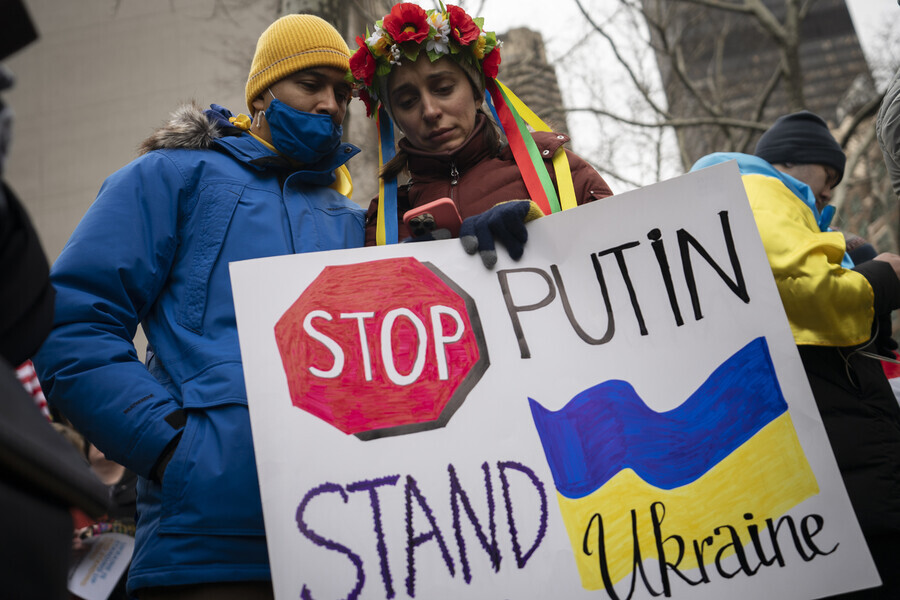hankyoreh
Links to other country sites 다른 나라 사이트 링크
S. Korean chipmakers, automakers brace for effects of protracted crisis in Ukraine

South Korean exporters are on edge as the US moves to impose export restrictions on Russia following its invasion of Ukraine. Because Russia doesn’t account for a large share of Korea’s exports, these restrictions aren’t likely to have a major impact in the short term. But if the situation drags on, it could disrupt the supply of raw materials. Korea’s financial markets stabilized following severe volatility following Russia’s invasion on Thursday.
“Not all exports bound for Russia are blocked. The US’ basic embargo strategy is to prevent 57 items and technologies on the sanctions list from being exported from the US to Russia,” a key official at Korea’s Ministry of Trade, Industry and Energy told the Hankyoreh on Friday.
The US Department of Commerce announced on Thursday that it was adding 57 items and technologies in the areas of electronics (semiconductors), computers, information and communications, sensors and lasers, navigation and aviation electronics, maritime, and aerospace to its embargo against Russia.
The US action that could directly impact Korean industry is its plan to apply the rule about foreign-produced direct products on a broader basis. That rule bans the export of products made outside the US when American software or designs are used in the manufacturing process. That could impact the semiconductors, automobiles and electronic goods that Korea exports to Russia.
Companies say they aren’t very concerned, at least in the short term. “Our semiconductor trade with Russia is very marginal,” said a source at one chipmaker. Indeed, Russia only accounted for 0.06% of Korea’s total semiconductor exports last year in terms of value.
There’s more concern that production could be disrupted if stockpiles of raw materials run low during a protracted crisis. “I think the key factor will be how much [raw materials] are in inventories,” said Kim Yang-paeng, an analyst for the Korea Institute for Industrial Economics and Trade.
Ukraine accounts for a relatively high portion (30.7%) of the krypton used to make semiconductors.
The mood in the automobile industry is generally the same.
The Korean government reviewed a variety of possible actions in a meeting of related ministers that was presided over by Hong Nam-ki, who serves as the minister of economy and finance and deputy prime minister.
The government’s first step was agreeing to bolster financial conditions by promising to quickly repay deposits and by extending credit guarantees for exporters over the next month. It has also activated an “emergency financial assistance program” that can be used when import-export firms suffer damage of up to 2 trillion won, or roughly US$1.66 billion. That came in response to some commercial banks’ decision to reduce credit limits for companies that are linked directly or indirectly to the situation in Ukraine.
Korean financial markets rebounded from major losses the previous day as they appeared to enter a wait-and-see period. Korea’s benchmark KOSPI and secondary KOSDAQ both closed up from the previous day — 1.06% and 2.92%, respectively — and the yield on three-year treasury bonds rose 0.018 points (indicating bond values were declining) as calm returned to the markets.
The won-dollar exchange rate closed the day at 1,201.6 won, declining 0.8 won as the won rose in value.
By Lee Ji-hye, staff reporter; Kim Young-bae, senior staff writer; Ahn Tae-ho, staff reporter; Sun Dam-eun
Please direct questions or comments to [english@hani.co.kr]

Editorial・opinion
![[Guest essay] Maybe Korea’s rapid population decline is an opportunity, not a crisis [Guest essay] Maybe Korea’s rapid population decline is an opportunity, not a crisis](https://flexible.img.hani.co.kr/flexible/normal/500/300/imgdb/original/2024/0430/9417144634983596.jpg) [Guest essay] Maybe Korea’s rapid population decline is an opportunity, not a crisis
[Guest essay] Maybe Korea’s rapid population decline is an opportunity, not a crisis![[Column] Can Yoon steer diplomacy with Russia, China back on track? [Column] Can Yoon steer diplomacy with Russia, China back on track?](https://flexible.img.hani.co.kr/flexible/normal/500/300/imgdb/original/2024/0430/1617144616798244.jpg) [Column] Can Yoon steer diplomacy with Russia, China back on track?
[Column] Can Yoon steer diplomacy with Russia, China back on track?- [Column] Season 2 of special prosecutor probe may be coming to Korea soon
- [Column] Park Geun-hye déjà vu in Yoon Suk-yeol
- [Editorial] New weight of N. Korea’s nuclear threats makes dialogue all the more urgent
- [Guest essay] The real reason Korea’s new right wants to dub Rhee a founding father
- [Column] ‘Choson’: Is it time we start referring to N. Korea in its own terms?
- [Editorial] Japan’s rewriting of history with Korea has gone too far
- [Column] The president’s questionable capacity for dialogue
- [Column] Are chaebol firms just pizza pies for families to divvy up as they please?
Most viewed articles
- 1Under conservative chief, Korea’s TRC brands teenage wartime massacre victims as traitors
- 2[Guest essay] Maybe Korea’s rapid population decline is an opportunity, not a crisis
- 3Value of Korean won down 7.3% in 2024, a steeper plunge than during 2008 crisis
- 4Two factors that’ll decide if Korea’s economy keeps on its upward trend
- 5[Column] Can Yoon steer diplomacy with Russia, China back on track?
- 6Dermatology, plastic surgery drove record medical tourism to Korea in 2023
- 7After election rout, Yoon’s left with 3 choices for dealing with the opposition
- 8Why Kim Jong-un is scrapping the term ‘Day of the Sun’ and toning down fanfare for predecessors
- 9Strong dollar isn’t all that’s pushing won exchange rate into to 1,400 range
- 10‘We must say no’: Seoul defense chief on Korean, USFK involvement in hypothetical Taiwan crisis